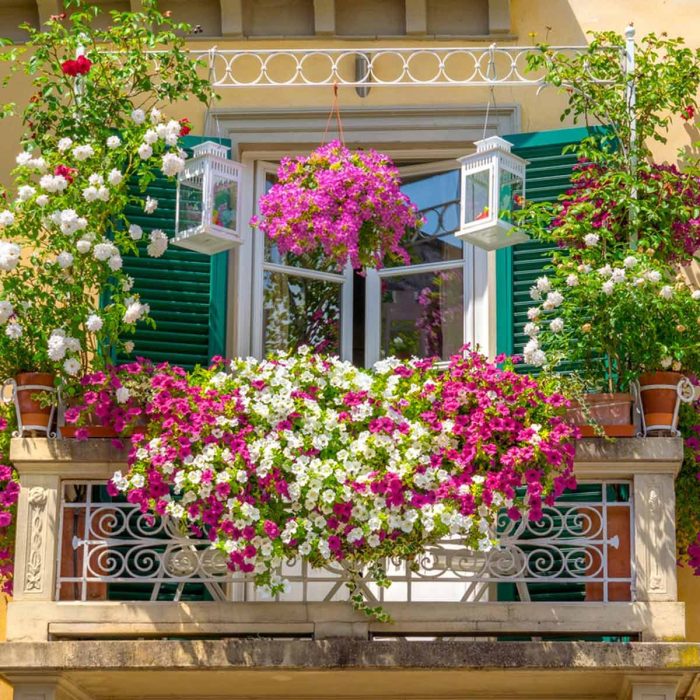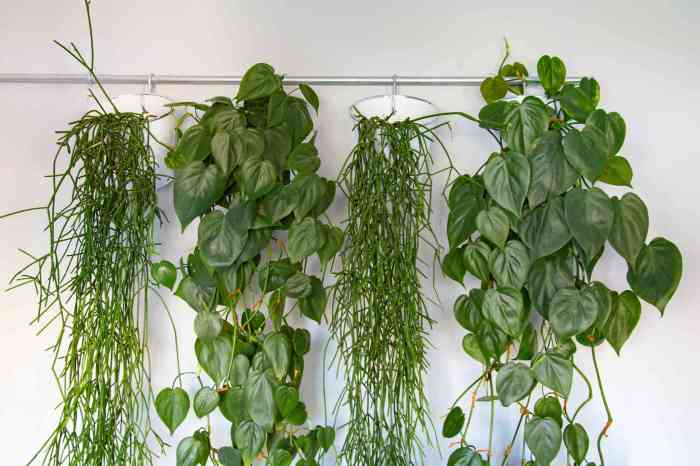Hanging plants garden offer a unique and captivating way to add greenery and life to any space. Whether you’re a seasoned gardener or just starting out, this guide will provide you with all the information you need to create a thriving hanging plant garden that will bring joy and beauty to your home or outdoor area.
From choosing the right plants to designing and caring for your hanging garden, we’ll cover everything you need to know to get started. So sit back, relax, and let’s explore the wonderful world of hanging plants garden.
Hanging Plant Species

Hanging plants bring a touch of greenery and tranquility to any space, whether indoors or outdoors. They are a versatile addition to any garden, offering a range of colors, textures, and growth habits to suit different environments and lighting conditions.
When choosing hanging plants, it is important to consider their growth habits, foliage characteristics, and blooming periods. Some popular hanging plant species include:
Trailing Plants
- String of Pearls (Senecio rowleyanus): This succulent plant features long, trailing stems adorned with plump, bead-like leaves. It prefers bright, indirect light and moderate watering.
- Burro’s Tail (Sedum morganianum): Another succulent, Burro’s Tail has cascading stems with plump, blue-green leaves. It thrives in full sun to partial shade and requires infrequent watering.
- Spider Plant (Chlorophytum comosum): A popular indoor plant, Spider Plant produces long, arching leaves with white or variegated stripes. It tolerates a wide range of lighting conditions and is easy to care for.
Trailing Vines
- Pothos (Epipremnum aureum): A fast-growing vine with heart-shaped leaves, Pothos is known for its tolerance to low light and infrequent watering.
- Philodendron (Philodendron spp.): A diverse genus of vines with a wide range of leaf shapes and sizes. Philodendrons generally prefer bright, indirect light and moderate watering.
- String of Hearts (Ceropegia woodii): A trailing vine with heart-shaped leaves adorned with silvery markings. It prefers bright, indirect light and moderate watering.
Epiphytic Plants
- Staghorn Fern (Platycerium spp.): This unique fern has large, antler-like fronds that attach to trees or other supports. It prefers bright, indirect light and moderate humidity.
- Tillandsia (Tillandsia spp.): Also known as air plants, Tillandsias are epiphytes that absorb moisture and nutrients from the air. They come in a variety of shapes and sizes and prefer bright, indirect light.
- Orchid (Orchidaceae spp.): A diverse group of flowering plants, orchids come in a wide range of sizes and colors. They generally prefer bright, indirect light and specific watering requirements depending on the species.
Vertical Gardening with Hanging Plants

Hanging plants are a versatile way to maximize vertical space in a garden, creating lush green walls and adding a touch of nature to any setting. Whether you have a small balcony, a narrow courtyard, or a large backyard, vertical gardening with hanging plants offers numerous benefits and creative possibilities.
One of the key advantages of vertical gardening is its space-saving nature. By utilizing vertical space, you can grow a wide variety of plants without taking up valuable ground space. This makes it an ideal solution for urban environments, small gardens, and balconies where space is limited.
Hanging plants gardens are a beautiful and versatile way to add greenery to your home. They can be used to create a living wall, add a touch of elegance to a room, or simply bring the outdoors in. If you’re looking for a way to add some life to your home, consider adding a hanging plants garden.
Hanging baskets bunnings are a great way to get started, as they come in a variety of sizes and styles to suit any space. Once you’ve chosen your baskets, you can fill them with a variety of plants, such as ferns, succulents, or flowers.
With a little care and attention, your hanging plants garden will thrive and bring you years of enjoyment.
Creating Vertical Plant Walls
Vertical plant walls are a stunning way to transform a bare wall into a living tapestry. They can be created using a variety of materials, such as trellises, wire mesh, or repurposed pallets. Choose plants that are suitable for vertical growth, such as ivy, ferns, or trailing succulents.
Arrange the plants on the wall in a pleasing pattern, and secure them using plant clips or wire.
Hanging Planters
Hanging planters are a versatile option for vertical gardening. They can be suspended from ceilings, walls, or balconies, and come in a wide range of styles and materials. Choose planters that are large enough to accommodate the root systems of your plants, and ensure they have adequate drainage holes.
Trellises
Trellises are vertical structures that provide support for climbing plants. They can be made from wood, metal, or plastic, and come in a variety of shapes and sizes. Train climbing plants, such as clematis, roses, or honeysuckle, to grow up the trellis, creating a beautiful and fragrant vertical display.
Design Considerations for Hanging Plant Gardens
Creating a visually appealing hanging plant garden requires careful consideration of design elements. Choosing the right plants, incorporating color, texture, and height, and addressing factors like sunlight exposure and water requirements are crucial for a successful arrangement.
Plant Selection
Select hanging plants that complement the desired aesthetic and theme of the garden. Consider factors such as leaf shape, size, and color. For a lush, tropical look, opt for plants like ferns, pothos, and philodendrons. For a more delicate touch, choose trailing plants like ivy, string of pearls, or spider plants.
Hanging plants gardens are a popular way to add greenery and life to your home. They can be used to create a variety of looks, from lush and tropical to modern and minimalist. If you’re looking for hanging plants that can tolerate low light conditions, there are many great options to choose from.
Hanging plants that like low light include pothos, snake plants, and ZZ plants. These plants are all relatively easy to care for, and they can add a touch of greenery to any room in your home.
Color and Texture
Incorporate a variety of colors and textures to create a visually appealing arrangement. Use contrasting colors to create a bold statement or stick to a monochromatic scheme for a more subtle effect. Combine plants with different leaf textures, such as smooth, velvety, or variegated, to add depth and interest.
Height and Arrangement
Vary the height of plants to create a dynamic display. Place taller plants in the center or at the back, and cascade smaller plants over the sides. Experiment with different arrangements to find a balance that creates a visually pleasing flow.
The hanging plants garden is a beautiful and unique way to add some greenery to your home. Hanging plants can be used to create a variety of different looks, from lush and tropical to minimalist and modern. If you’re looking for a low-maintenance way to add some life to your space, consider hanging air plants.
Hanging air plants are a great option for beginners, as they don’t require any soil or watering. They simply need to be misted with water every few days. Hanging plants are a great way to add some personality to your home, and they can also help to improve air quality.
Sunlight and Water
Consider the sunlight exposure and water requirements of the plants when designing the garden. Group plants with similar needs together to ensure they receive optimal care. Choose drought-tolerant plants for areas with limited sunlight or water, and water-loving plants for areas with ample moisture.
Hanging Plant Care and Maintenance

Nurturing hanging plants requires specific care and maintenance practices to ensure their health and longevity. This involves providing adequate watering, fertilizing, and pruning, while also safeguarding against pests and diseases.
Watering
Hanging plants have specific watering needs due to their aerial position. They tend to dry out faster than ground-based plants, so regular watering is crucial. The frequency of watering depends on factors like plant species, pot size, and environmental conditions.
- Check the soil moisture regularly by inserting a finger into the potting mix. Water when the top inch or two of soil feels dry to the touch.
- Water thoroughly, allowing excess water to drain from the drainage holes. Avoid overwatering, as it can lead to root rot.
Fertilizing
Fertilizing hanging plants provides essential nutrients for growth and vitality. Use a balanced liquid fertilizer diluted to half strength and apply it during the growing season (spring and summer).
- Fertilize monthly or as recommended on the fertilizer label.
- Avoid overfertilizing, as it can burn the plant’s roots.
Pruning
Pruning hanging plants promotes healthy growth, removes dead or damaged foliage, and encourages bushier plants. Prune as needed throughout the year, using sharp, clean shears.
- Remove any dead, yellowing, or diseased leaves or stems.
- Trim back overgrown stems to encourage bushier growth.
Common Pests and Diseases
Hanging plants are susceptible to various pests and diseases, including aphids, mealybugs, spider mites, and fungal infections. Regular inspection and prompt treatment are essential for preventing infestations and diseases.
- Aphids and mealybugs can be controlled with insecticidal soap or neem oil.
- Spider mites can be treated with insecticidal soap or horticultural oil.
- Fungal infections, such as powdery mildew, can be prevented by ensuring good air circulation and avoiding overwatering.
Creative Ideas for Hanging Plant Gardens
Hanging plant gardens offer a unique and versatile way to add greenery to any space. From indoor living rooms to outdoor patios, hanging plants can create a lush and inviting atmosphere.
Here are a few creative ideas for hanging plant gardens:
Macrame Hangers
Macrame hangers are a popular way to display hanging plants. They add a touch of bohemian style to any space and are easy to make yourself. Simply knot macrame cord around a ring or dowel and attach your plants.
Kokedama, Hanging plants garden
Kokedama is a Japanese art form that involves suspending plants in a ball of moss. This creates a unique and eye-catching display that is perfect for small spaces.
Plant Shelves
Plant shelves are a great way to display multiple hanging plants in a vertical space. They can be made from wood, metal, or other materials and can be customized to fit any space.
Hanging Plant Installations
Hanging plant installations can be used to create a dramatic statement in any space. They can be made from a variety of materials, such as wire, rope, or fabric, and can be customized to fit any space.
End of Discussion: Hanging Plants Garden

Hanging plant gardens are a beautiful and versatile way to add greenery and life to any space. With a little planning and care, you can create a thriving hanging garden that will bring you years of enjoyment.
Key Questions Answered
What are the best hanging plants for beginners?
Some of the best hanging plants for beginners include pothos, spider plants, and philodendrons. These plants are relatively easy to care for and can tolerate a wide range of conditions.
How often should I water my hanging plants?
The frequency with which you water your hanging plants will depend on the type of plant, the size of the pot, and the humidity of your home. As a general rule, you should water your plants when the top inch of soil feels dry to the touch.
How can I create a vertical plant wall?
There are a number of ways to create a vertical plant wall. One popular method is to use a trellis or grid system. You can also use hanging planters or macrame hangers to create a vertical display.